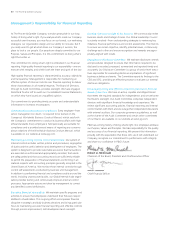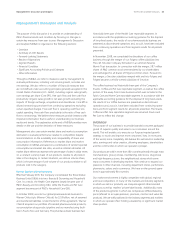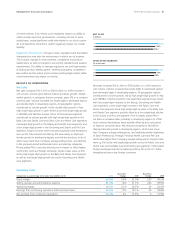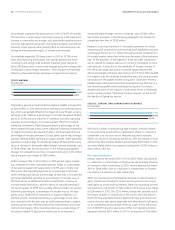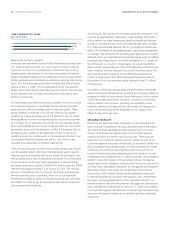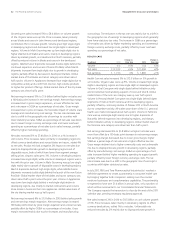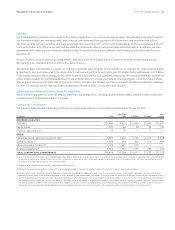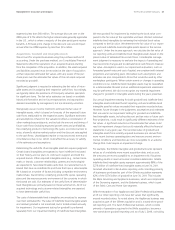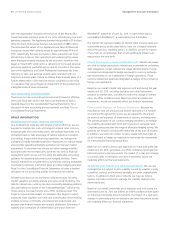Proctor and Gamble 2011 Annual Report Download - page 42
Download and view the complete annual report
Please find page 42 of the 2011 Proctor and Gamble annual report below. You can navigate through the pages in the report by either clicking on the pages listed below, or by using the keyword search tool below to find specific information within the annual report.
40 The Procter & Gamble CompanyManagement’s Discussion and Analysis
$.47
$3.95
$3.67
11
09
10
CORE EARNINGS PER SHARE
(per common share)
Venezuela Currency Impacts
Venezuela was determined to be a highly inflationary economy under
U.S. GAAP during fiscal .As a result, the U.S. dollar is now the
functional currency for our subsidiaries in Venezuela. Any currency
remeasurement adjustments for non-dollar denominated monetary
assets and liabilitiesheld by these subsidiaries and other transactional
foreign exchange gains and losses are reflected in earnings. Also during
fiscal 2010, the Venezuelan government devalued the Bolivar Fuerte
relative to the U.S. dollar. The remeasurement of our local balance
sheets in fiscal 2010 did not materially impact our results. This was due
to the relatively small non-dollar denominated net monetary asset
position in Venezuela.
The Venezuelan government introduced a number of currency controls
for companies operating in Venezuela. During calendar year 2010,
there were two official exchange rates for imported goods. Those
goods classified as essential, such as food, medicine and capital
investments, had an exchange rate of 2.6bolivars to the U.S. dollar,
while payments for other non-essential goods had an exchange rate
of 4.3.Many of our imported products fell into the essential classifi-
cation and qualified for the 2.6rate.In January 2011, the Venezuelan
government announced the elimination of the 2.6exchange rate on
essential goods, resulting in the application of the 4.3rate to all
qualifying goods. Our overall results in Venezuela are reflected in our
Consolidated Financial Statements at the 4.3rate, which is also
expected to be applicable to dividend repatriations.
There are also exchange controls over securities transactions in what
was the parallel market, which has historically been used to pay for
imported goods and services that do not qualify for exchange in the
official market and is now controlled by authorities. The Central Bank
of Venezuela is now the only legal intermediary to execute foreign
exchange transactions outside of CADIVI (4.3rate) through the SITME
rate which was approximately 5.3as of June30,2011. The notional
amount of transactions that run through this foreign exchange rate
for non-essential goods is restrictive, which for us has essentially
eliminated our ability to access any foreign exchange rate other than
the CADIVI (4.3) rate to pay for imported goods and/or manage our
local monetary asset balances.
As of June30,2011, we had net monetary assets denominated in local
currency of approximately $798 million. Approximately $347million
of this balance has been remeasured using the parallel rate because
we plan to use that amount of the net assets (largely cash) to satisfy
U.S.dollar denominated liabilities that do not qualify for official rate
dollars. The availability of the parallel market to settle these transactions
is uncertain. The remaining net monetary asset balances are currently
reflected within ourConsolidated Financial Statements at the 4.3official
exchange rate. Depending on the future availability of U.S. dollars at
the official rate, our local U.S. dollar needs, our overall repatriation
plans and the creditworthiness of the local depository institutions and
other creditors, we have exposure for our local monetary assets. We
also have devaluation exposure for the differential between the
current and potential future official and parallel exchange rates on
the portion of our local monetary assets reflected at the 4.3official
exchange rate.
Our ability to effectively manage sales and profit levels in Venezuela
will be impacted by several factors, including the Company’s ability to
mitigate the effect of any potential future devaluation, further actions
of the Venezuelan government, economic conditions in Venezuela,
such as inflation and consumer spending, the availability of raw
materials, utilities and energy and the future state of exchange con-
trols in Venezuela including the availability of U.S. dollars at the
official foreign exchange rate.
SEGMENT RESULTS
Results for the segments reflect information on the same basis we
usefor internal management reporting and performance evaluation.
The results of these reportable business segments do not include
certain non-business unit specific costs such as interest expense,
investing activities and certain restructuring costs. These costs are
reported in our Corporate segment and are included as part of our
Corporate segment discussion. Additionally, as described in Note 11 to
the Consolidated Financial Statements, we have investments in certain
companies over which we exert significant influence, but do not
control the financial and operating decisions and, therefore, do not
consolidate these companies for U.S. GAAP purposes (“unconsolidated
entities”). Given that certain of these investments are managed as
integral parts of the Company’s business units, they are accounted for
as if they were consolidated subsidiaries for management and segment
reporting purposes. This means pre-tax earnings in the business
unitsinclude 100% of each pre-tax income statement component.
Indetermining after-tax earnings in the business units, we eliminate
the share of earnings applicable to other ownership interests, in a
manner similar to noncontrolling interest, and apply the statutory tax
rates. Eliminations to adjust each line item to U.S. GAAP are included in
our Corporate segment. All references to net earnings throughout the
discussion of segment results refer to net earnings from continuing
operations.


